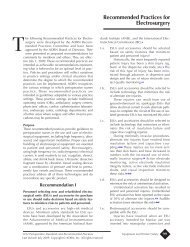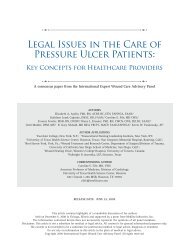2009 CAUTI guidelines - Centers for Disease Control and Prevention
2009 CAUTI guidelines - Centers for Disease Control and Prevention
2009 CAUTI guidelines - Centers for Disease Control and Prevention
Create successful ePaper yourself
Turn your PDF publications into a flip-book with our unique Google optimized e-Paper software.
a. Clamping vs. free drainage prior to removalLow-quality evidence suggested no benefit of clamping versus free drainage be<strong>for</strong>e catheterremoval. 37,184 This was based on no difference in risk of bacteriuria, urinary retention, orrecatheterization between the two strategies. One study comparing a clamp <strong>and</strong> releasestrategy to free drainage over 72 hours found a greater risk of bacteriuria in the clamping group.b. Postoperative duration of catheterizationModerate-quality evidence suggested a benefit of shorter versus longer postoperative durationsof catheterization. 37,184,227,228 This was based on a decreased risk of bacteriuria/unspecified UTI,decreased time to ambulation <strong>and</strong> length of stay, no differences in urinary retention <strong>and</strong> SUTI,<strong>and</strong> increased risk of recatheterization. Significant decreases in bacteriuria/unspecified UTIwere found specifically <strong>for</strong> comparisons of 1 day versus 3 or 5 days of postoperativecatheterization. Recatheterization risk was greater in only one study comparing immediateremoval to removal 6 or 12 hours after hysterectomy.Q2C.12. Assessment of urine volumesLow-quality evidence suggested a benefit of using portable ultrasound to assess urine volume inpatients undergoing intermittent catheterization. 229,230 This was based on fewer catheterizationsbut no reported differences in risk of unspecified UTI. Patients studied were adults withneurogenic bladder in inpatient rehabilitation centers. Our search did not reveal data on the useof ultrasound in catheterized patients in other settings.Evidence Review Table 2C. What are the risks <strong>and</strong> benefits associated with differentcatheter management techniques?2C.1. Unless clinical indications exist (e.g., in patients with bacteriuria upon catheter removalpost urologic surgery), do not use systemic antimicrobials routinely as prophylaxis <strong>for</strong> UTI inpatients requiring either short or long-term catheterization. (Category IB)2C.2.a. Further research is needed on the use of urinary antiseptics (e.g., methanamine) toprevent UTI in patients requiring short-term catheterization. (No recommendation/unresolvedissue)2C.2.b. Further research is needed on the use of methanamine to prevent encrustation inpatients requiring chronic indwelling catheters who are at high risk <strong>for</strong> obstruction. (Norecommendation/unresolved issue)2C.3.a. Unless obstruction is anticipated (e.g., as might occur with bleeding after prostatic orbladder surgery), bladder irrigation is not recommended. (Category II)2C.3.b. Routine irrigation of the bladder with antimicrobials is not recommended. (Category II)2C.4. Routine instillation of antiseptic or antimicrobial solutions into urinary drainage bags is notrecommended. (Category II)2C.5.a. Do not clean the periurethral area with antiseptics to prevent <strong>CAUTI</strong> while the catheteris in place. Routine hygiene (e.g., cleansing of the meatal surface during daily bathing) is44
















